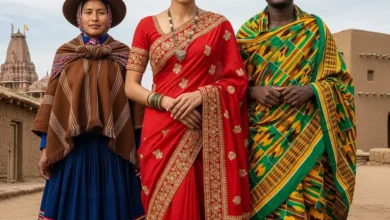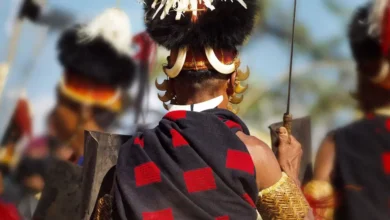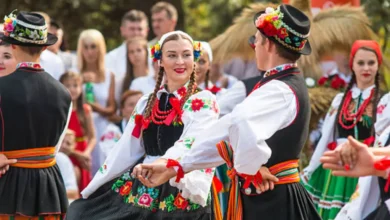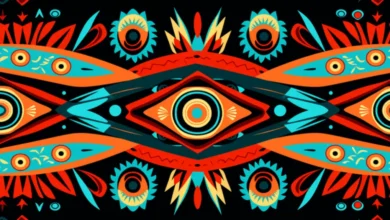Your Ancestors Didn’t Just Wear Cloth — They Wore Prayers
That dragon coiling down your sleeve?
That goddess woven into your hem?
That thunderbird beaded across your chest?
It wasn’t “just decoration.”
It was an invocation.
A covenant.
A whispered plea.
A sacred alliance.
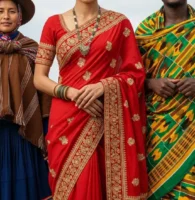 Color Symbolism in Ethnic Clothing: Meanings Behind Vibrant Hues
Color Symbolism in Ethnic Clothing: Meanings Behind Vibrant HuesFor thousands of years — across every continent — people stitched mythological icons into their clothing not to look beautiful…
…but to be protected.
To be guided.
To be remembered by the gods.
In this article, you’ll discover:
- 🐉 What mythological icons in folk attire really mean — beyond aesthetics
- 🌍 Real examples from Slavic, Navajo, Hindu, Japanese, Yoruba, Andean, Celtic, Balinese, and global spiritual traditions
- 🙏 How deity patterns + spirit creatures invoke protection, blessing, transformation
- ⚠️ The quiet erasure of sacred symbols — and powerful modern revival
- ✂️ How to appreciate (or create!) spiritual designs ethically
- 🧵 A simple DIY guide to design your own spirit-inspired pattern — rooted in personal reverence, not appropriation
- 💬 Strong, respectful Call to Action — because deities should never be décor
Let’s begin — one prayer, one stitch at a time.
See also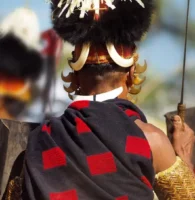 Ritual Symbols in Folk Costumes: Social Significance and Ceremony Designs
Ritual Symbols in Folk Costumes: Social Significance and Ceremony DesignsWhat Are Mythological Icons in Folk Attire? (Plain & Simple)
Mythological icons in folk attire = images of gods, goddesses, spirit animals, or sacred creatures woven, embroidered, printed, or beaded onto clothing to invoke divine presence, protection, or blessing.
Think:
- Ukrainian vyshyvankas with Berehynia (goddess) motifs → feminine power + home protection
- Navajo dresses with Ye’ii (Holy People) figures → healing + balance
- Balinese kebaya with Barong masks → warding off Rangda’s chaos
- Japanese kimonos with Fujin (wind god) → safe travel, clearing stagnation
- Yoruba gele headwraps with Oshun river motifs → love, abundance, intuition
- Andean ponchos with Apus (mountain spirits) → guidance + strength
- Celtic cloaks with Cernunnos stag antlers → wild wisdom + fertility
- Hindu saris with Lakshmi lotus feet → prosperity + grace
These aren’t costumes.
They’re altars in motion. Divine contracts in thread.
“We didn’t dress for the eyes of men. We dressed for the gaze of gods.”
— Slavic village elder
Why Did Cultures Sew Gods Into Their Clothes?
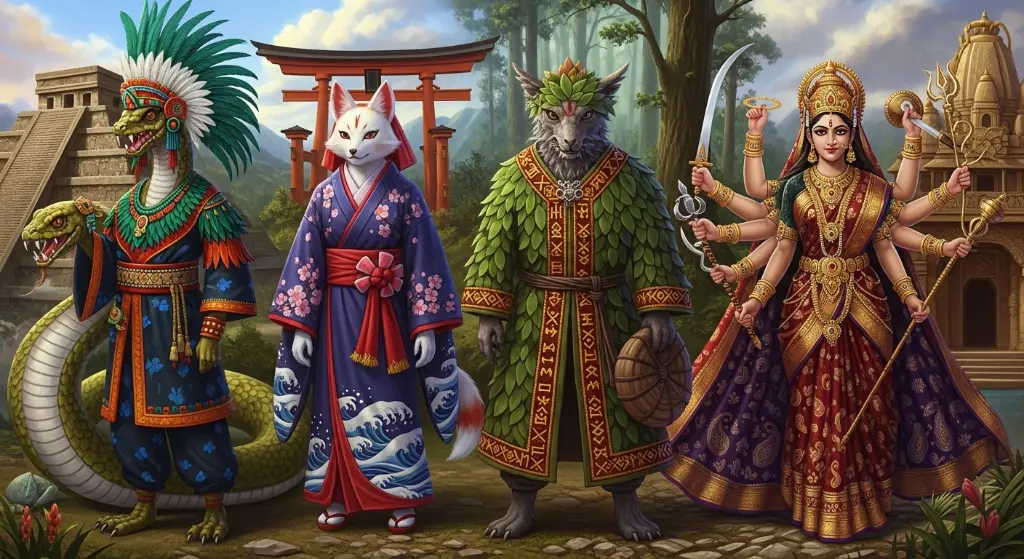
Because survival wasn’t just physical.
It was spiritual.
Before hospitals. Before police. Before locks on doors — people relied on:
- Divine favor
- Spirit allies
- Ancestral guardians
- Thread + intention
Clothing became the first temple.
Here’s why it worked:
1. Proximity = Power
Wear the god close to skin → invite their energy into your day.
Collar? Protects throat + truth.
Chest? Shields heart + devotion.
Hem? Grounds steps + path.
Placement = sacred architecture.
2. Symbols Summon Presence
A coiled dragon isn’t “art.”
It’s an invitation: Come, Shenlong. Bring rain.
A lotus foot isn’t “pretty.”
It’s a call: Lakshmi, bless this home.
Thread becomes incense. Fabric becomes offering.
3. Protection Through Divine Witness
Evil spirits? Bad luck? Curses?
Many believed deities watching from your sleeve would intervene.
“If the god walks with you, no shadow dares follow.”
— Balinese priestess
4. Identity Beyond Tribe — Connection to Cosmos
Your clan matters. Your village matters.
But so does your relationship with sky, storm, sea, soil.
Deity patterns said: I belong to something vaster.
Quick Guide: Global Mythological Icons in Clothing
| Deity / Creature | Culture(s) | Where It Appears | Meaning |
|---|---|---|---|
| 🐉 Dragon | Chinese, Vietnamese, Korean | Robes, sashes, festival wear | Rain, power, imperial blessing |
| 🕊️ Dove + Tree | Slavic (Berehynia) | Women’s blouses, aprons | Home, hearth, feminine divine |
| 👁️ Thunderbird | Navajo, Hopi, Ojibwe | Blankets, dance regalia | Storm, transformation, divine messenger |
| 🐅 Barong | Balinese | Ceremonial kebaya, temple wear | Chaos-balancer, protector from Rangda |
| 💨 Fujin | Japanese | Kimonos, traveler’s coats | Wind, movement, clearing stagnation |
| 🌊 Oshun | Yoruba | Gele headwraps, beaded gowns | Love, rivers, sweetness, intuition |
| ⛰️ Apus | Andean (Quechua/Aymara) | Ponchos, hats, belts | Mountain spirits, guidance, strength |
| 🦌 Cernunnos | Celtic | Cloaks, belts, ritual robes | Wild masculine, fertility, underworld |
| 🪷 Lakshmi Feet | Hindu | Saris, wedding veils | Prosperity, grace, divine nourishment |
| 🐺 Fenrir | Norse | Warrior tunics, rune cloaks | Untamed power, inevitable change |
Now — let’s meet each icon up close.
🐉 Dragons: Not Monsters — Messengers of Heaven
In East Asia, dragons don’t destroy.
They bless.
China — Imperial Robes with Five-Clawed Dragons
Only emperors wore five-clawed dragons → symbol of heaven’s mandate.
Four claws? Nobles. Three? Officials.
Stitched in gold + blue → sky + water harmony.
Worn during solstice ceremonies — to align human rule with cosmic order.
“The dragon doesn’t hoard gold. It carries rain.”
— Taoist proverb
Vietnam — Mother Dragon on Áo Dài
Áo dài (long dress) often features Lạc Long Quân — dragon king + father of Vietnamese people.
Worn during Tết (New Year) — to invoke national protection + unity.
Scales stitched in green + silver → river + moon energy.
Korea — Cloud-Dragons on Hanbok
Dragons wrapped in mist → symbol of hidden wisdom.
Worn by scholars, healers, midwives — those who navigate unseen realms.
“True power moves like mist — felt, not seen.”
— Korean shaman
🕊️ Berehynia: Slavic Goddess Who Holds the Home
Before Christianity, Eastern Europe honored Berehynia — goddess of hearth, home, birds, trees.
Still stitched today — quietly, fiercely.
Ukraine — Dove + Tree on Vyshyvankas
Dove = peace + soul.
Tree = ancestry + growth.
Often placed over chest — protecting heart + lineage.
Red thread = life force. Black = ancestral memory.
Worn by women during childbirth, war, migration — to say: I carry sanctuary with me.
“When bombs fall, we stitch more doves. So the goddess remembers where to land.”
— Oksana, Lviv embroiderer
Poland — Triple Goddess Spirals on Aprons
Maiden-Mother-Crone as interlocking spirals.
Worn during solstices — to honor feminine cycles + earth’s turning.
👁️ Thunderbird: Sky’s Holy Messenger
Among many Native nations — especially Navajo, Hopi, Ojibwe — the Thunderbird is not myth.
It is meteorology + metaphysics.
Navajo — Ye’ii Figures on Blankets + Dresses
Ye’ii = Holy People who walk between worlds.
Often shown with lightning zigzags, feathered headdresses.
Worn during healing ceremonies — to invite balance, cleansing, divine intervention.
Placement: near shoulders → carrying prayers upward.
“The Thunderbird doesn’t frighten us. It reminds us: storms bring renewal.”
— Diné elder
Pacific Northwest — Raven + Thunderbird on Button Blankets
Raven = trickster + creator.
Thunderbird = storm-bringer + transformer.
Worn during potlatch — invoking ancestral presence + cosmic power.
Colors: black (raven), red (thunder), white (lightning).
🐅 Barong: Bali’s Gentle Giant Against Chaos
In Bali, good doesn’t defeat evil.
It dances with it.
Barong (lion-dragon creature) vs Rangda (witch queen) = eternal balance.
Balinese Kebaya — Barong Masks on Sleeves
Women’s lace blouses feature tiny Barong faces near cuffs.
Why? To guard hands — what they touch, create, offer.
Worn during temple festivals — especially Galungan, when spirits visit earth.
“Don’t fear chaos. Invite the dancer who tames it.”
— Balinese priest
💨 Fujin: Japan’s Wind God Who Clears the Way
Fujin — wild-haired, bag-carrying wind deity — appears on kimonos worn by travelers, merchants, students.
Traveler’s Kimono — Wind Bags + Tumbling Clouds
Stitched in indigo + white.
Worn before journeys — to ask: Clear my path. Blow away obstacles.
Also worn during exams, job interviews, hard conversations.
“Let Fujin scatter what no longer serves you.”
— Kyoto fortune slip
🌊 Oshun: Yoruba River Goddess of Sweetness
Oshun — honey-skinned, mirror-wielding, laughter-loving — rules rivers, love, art, abundance.
Her symbols flood West African and diaspora dress.
Nigeria — River Waves + Gold Beads on Gele
Yoruba women tie elaborate headwraps (gele) for weddings, festivals.
Gold beads = Oshun’s wealth.
Blue waves = her river (Osun).
Worn to attract love, creativity, financial flow.
“Dress like honey. Move like water. Laugh like Oshun.”
— Lagos market proverb
Brazil (Candomblé) — Yellow + Green Dresses
Followers wear Oshun’s colors during rituals.
Pattern: spiral → river’s curve. Dot → drop of honey.
Never worn casually. Only with prayer.
⛰️ Apus: Andean Mountain Spirits Who Hold the Sky
In Quechua and Aymara cosmology — mountains aren’t scenery.
They’re living beings. Teachers. Protectors.
Peru/Bolivia — Stepped Mountain Patterns on Ponchos
Each peak = an Apu (mountain spirit).
Worn by farmers, herders, healers — to ask for safe passage, fertile soil, clear vision.
Placement: back → letting the Apu watch over you.
“The mountain doesn’t move. But it sees everything. Stitch its gaze into your cloak.”
— Andean weaver
🦌 Cernunnos: Celtic Horned God of Wild Wisdom
Antlered. Serpent-belted. Cross-legged.
Cernunnos — lord of animals, forests, underworld — appears subtly in Celtic revival wear.
Ireland/Scotland — Stag Antlers on Cloaks + Belts
Woven in dark green + bronze thread.
Worn during Samhain — when veil thins between worlds.
Invokes: intuition, primal strength, death-as-transformation.
“The horned one doesn’t lead you out of the forest. He teaches you to belong there.”
— Druid saying
🪷 Lakshmi: Hindu Goddess Whose Feet Bless the Home
Lakshmi — lotus-seated, gold-coined, owl-riding — doesn’t need full portraits.
Her feet are enough.
India — Lotus Feet on Wedding Saris
Brides wear saris with Lakshmi’s footprints near hem.
Why? So wherever she walks, prosperity follows.
Gold thread = abundance. Red border = protection.
“She doesn’t ask for temples. She asks for thresholds swept clean.”
— Tamil devotional song
🐺 Fenrir: Norse Wolf Who Swallows the Sun (And Teaches Surrender)
Fenrir — bound wolf of prophecy — isn’t “evil.”
He is inevitability. Transformation. Uncontainable power.
Viking Revival — Fenrir Jaws on Tunics + Cloaks
Modern Heathens stitch Fenrir’s open maw near collar or hem.
Meaning: I accept what cannot be tamed. I prepare for change.
Worn during rites of passage — divorce, illness, rebirth.
“Don’t fear the wolf at the door. Thank him for reminding you: nothing lasts forever.”
— Norse rune reader
Colonialism Tried to Erase These Gods. Devotees Sewed Them Back.
Missionaries burned ceremonial robes.
Governments banned “idolatrous” dress.
Schools punished children for wearing deity patterns.
But the faithful?
They moved the gods.
Inside linings. Under collars. Into sock cuffs.
Used muted threads. Whispered names.
Passed them down like heirlooms — hidden in plain sight.
Today?
- Ukrainian women stitch extra Berehynia doves on soldiers’ shirts — praying for safe return
- Navajo weavers teach Ye’ii patterns to Gen Z — as acts of cultural medicine
- Balinese designers print Barong motifs on global streetwear — proudly reclaiming identity
- Yoruba priestesses trademark Oshun bead patterns — stopping fast fashion theft
- Andean youth wear Apu ponchos to climate protests — “The mountains are rising. So are we.”
“You can ban our cloth. But you can’t ban our gods.”
— Fatima-Zahra, Amazigh textile artist (echoed globally)
How to Wear Mythological Icons — The Right Way
Yes, you can admire them.
But please — never claim them as décor without devotion.
✅ DO:
- Learn the deity’s story, role, taboos before admiring their image
- Buy directly from spiritual practitioners — not Amazon, Shein, or Etsy resellers
- Ask if a design is restricted (many are for initiates only)
- Credit the culture, region, artist — always
- Wear with reverence — not as costume, trend, or “aesthetic”
❌ DON’T:
- Buy mass-produced “spirit animal” shirts with no cultural context
- Wear sacred ceremonial items (e.g., Navajo Ye’ii, Balinese Barong) to music festivals
- Say “I vibe with this goddess” without knowing her rituals or offerings
- Ignore requests from spiritual communities asking you not to commercialize their deity patterns
“Appreciation kneels. Appropriation poses.”
— Dr. Adrienne Keene, Cherokee Nation, @nativeappropriations
DIY: Create Your Own Spirit-Inspired Pattern (Ethically!)
Want to honor your own spiritual connection — without copying someone else’s sacred design?
Here’s how — respectfully, personally, powerfully.
Step 1: Sit Quietly. Ask — What Energy Do You Need?
Not “what looks cool.”
What do you need?
- Protection? → Imagine a shield, a guardian, a wall of light
- Guidance? → Imagine a path, a lantern, a bird in flight
- Release? → Imagine falling leaves, flowing water, untying knots
- Strength? → Imagine roots, mountains, clenched fists
Feel it. Don’t force it.
Step 2: Find Its Shape in Nature
Look outside. Or in memory.
Examples:
- Shield → turtle shell
- Path → river bend
- Release → dandelion puff
- Strength → oak bark texture
Sketch it. Simplify it.
Step 3: Turn It Into a Repeatable Symbol
Make it clean:
- Spiral for release
- Grid for protection
- Zigzag for guidance
- Circle for wholeness
Keep it abstract. Make it yours.
Step 4: Name It. Bless It. Stitch It.
Call it “River’s Curve Pattern” or “Turtle Shell Shield.”
Stitch it on a journal. Paint it on your altar. Print it on a scarf.
Say aloud: “This is mine. Made with need. Blessed by spirit.”
“Your ancestors didn’t cross oceans so you could wear someone else’s god. They crossed so you could meet your own.”
— Toko-pa Turner
Table: Where to Buy Ethically Made Spiritual Folk Wear
| Culture | Ethical Source | What They Sell |
|---|---|---|
| Navajo (Diné) | Toadlena Trading Post | Ye’ii-pattern ceremonial wear |
| Balinese | Threads of Life | Barong + temple-symbol textiles |
| Yoruba | Oshun’s Daughters Collective | Oshun-beaded gele + ritual gowns |
| Andean | Awamaki | Apu-mountain spirit ponchos |
| Slavic | Vyshyvanka Day Project | Berehynia dove + tree blouses |
| Japanese | Okamoto Textiles | Fujin wind god seasonal kimonos |
| Hindu | Sari Sutra | Lakshmi-footprint wedding saris |
| Celtic Revival | Morrigan’s Cloak (Ireland) | Cernunnos antler wool cloaks |
⚠️ Avoid mass retailers. Support living spiritual artists directly.
Why This Matters More Than Ever
We live in a world of digital noise. Empty trends. Algorithmic spirituality.
Mythological icons in folk attire offer something radical:
Depth. Reverence. Relationship.
When you wear a thunderbird — you honor storm’s wisdom.
When you stitch Oshun’s wave — you invite flow into your life.
When you trace Lakshmi’s foot — you bless your home with grace.
These patterns are anchors.
They whisper:
Slow down.
Kneel sometimes.
Give thanks.
You are walked with — by powers older than fear.
“In a distracted world, thread becomes prayer. Cloth becomes temple.”
— Balinese weaver
Know Your Spirits. Honor Others’. Stitch With Care.
You don’t need a robe to carry this wisdom.
Start small. Start true.
🙏 1. Pick One Deity or Spirit Creature. Learn Its Story.
Read a book. Watch a doc. Follow a practitioner.
📚 Try:
- Braiding Sweetgrass by Robin Wall Kimmerer (for animist worldview)
- Goddesses in Everywoman by Jean Shinoda Bolen
- The Book of Symbols by ARAS (archetypal imagery)
- Indigenous Religions edited by Graham Harvey
🧵 2. Support Real Spiritual Artists
Buy direct. Pay fairly. Share their work.
Search: “[Culture] + spiritual textile artist + Instagram”
Follow: #SacredStitches #WearTheDivine #MythInThread
✏️ 3. Make Your Own Symbol
Use the DIY guide above.
Name it. Bless it. Wear it proudly — as YOUR spiritual ally.
🗣️ 4. Speak Up
See sacred deity patterns sold as “boho chic”? Gently correct.
See elders ignored? Amplify them.
See spiritual erasure? Donate. Volunteer. Educate.
🌱 5. Give Back
Donate to Indigenous land-back + language revival funds.
Plant native species tied to local deities.
Clean rivers, springs, mountains — homes of spirits.
Teach a child one mythological symbol — and its true origin.
“Honor the hands that wove the first prayers. Then weave your own.”
— Winona LaDuke
Final Thought: You Are Walked With
Next time you see a dragon on a cuff, a goddess on a hem, a thunderbird on a shawl — pause.
That’s not “just fabric.”
That’s a grandmother tracing divine paths with thread.
A child learning which god guards their sleep.
A rebel reviving forbidden invocations.
Mythological icons in folk attire are alive.
Wear yours with love. Honor others’ with care. Pass them on — correctly.
And remember:
You, too, are accompanied.
By ancestors.
By spirits.
By deities who still listen.
Stitch that truth into your days.
💌 Loved this? Share it with someone seeking depth — gently, wisely, beautifully.
🧵 Follow #SacredStitches or #WearTheDivine on Instagram.
✏️ Grab thread. Sit quietly. Begin your spirit pattern.

